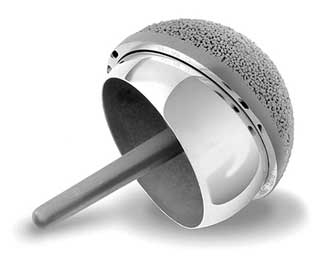Surface Replacements
Surface Replacements: A Bone-Conserving Hip Alternative
Surface hip replacement, also known as hip resurfacing, is an alternative treatment to traditional total hip replacement, particularly for younger, more active patients suffering from conditions like osteoarthritis, avascular necrosis, and post-traumatic arthritis. This procedure conserves more bone and uses a prosthetic hip joint designed to offer longevity and mobility.
For the past 30 years, total hip replacement has been the standard treatment for advanced hip arthritis. In this procedure, the upper portion of the femur, including the head and neck, is replaced with a stemmed device attached to a prosthetic head. A hemispherical cup is placed into the socket, with the bearing surface typically made from metal, ceramic, or polyethylene. While total hip replacement is highly effective at reducing pain and restoring mobility, over time, the artificial hip can wear down, loosen, and lead to discomfort, reduced function, and even bone loss.
In both traditional hip replacement and surface replacement, the socket is treated similarly. However, the preparation of the femur differs. In a typical hip replacement, the head and neck of the femur are removed to make way for a stemmed prosthetic that is inserted into the thigh bone. In contrast, hip resurfacing preserves the femoral head and neck. Instead of removing large portions of the femur, the remaining bone is shaped and fitted with a metal cap that includes a short stem.

Preserving bone in hip resurfacing offers several advantages. First, it maintains more of the femur’s natural bone structure, which is beneficial if the patient requires future surgeries. This is especially relevant for younger individuals who may need additional hip replacements later in life, as maintaining bone is crucial for the success of revision surgeries. Secondly, hip resurfacing allows for a larger ball size in the joint, which enhances stability and reduces the risk of dislocation. Studies have shown that the dislocation rate after hip resurfacing is about ten times lower than that of traditional hip replacement.
What is Total Hip Resurfacing?
Hip resurfacing, also known as surface replacement arthroplasty, is a less invasive surgical option for treating hip problems, especially in younger patients, compared to total hip replacement (THR). This technique conserves bone by capping the femoral head with a metal covering, rather than removing it entirely as done in THR, where both the femoral head and neck are amputated. Preserving these structures helps maintain a more natural gait after surgery. Additionally, because there is no long stem implanted into the femur, hip resurfacing offers a more natural feel and allows many patients to resume high-impact activities like running marathons or competing in triathlons. However, the procedure requires the patient to have sufficient bone quality to qualify for it.

